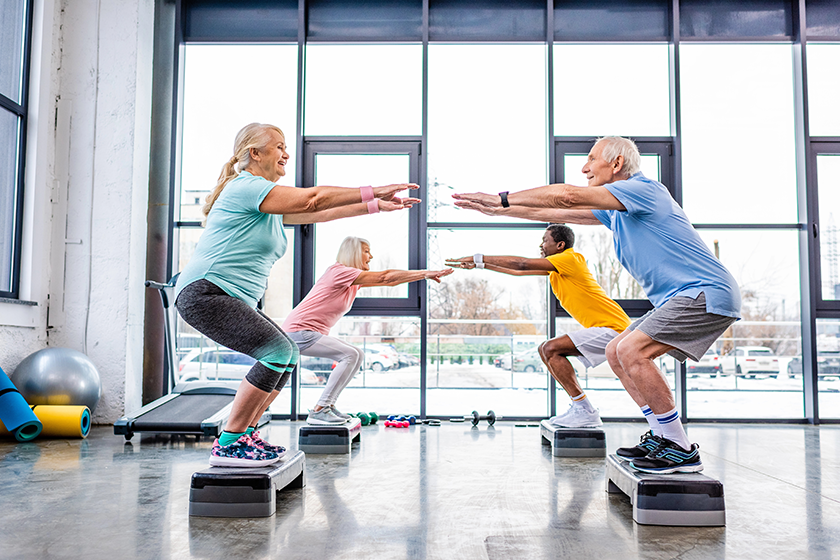As you age, maintaining strength and mobility becomes increasingly important. Among the many existing exercises, squats for seniors are a useful and accessible choice for boosting overall health and well-being. Squats are sometimes associated with weightlifting and intense workouts, but they provide many benefits for 55+ adults, helping them stay active and independent.
Increasing Strength and Stability
One of the main benefits of squats for seniors is their ability to improve lower body strength and stability. Targeting multiple muscle groups, the squat is a compound exercise for the quadriceps, hamstrings, glutes and calves. Strengthening these muscles is crucial for golden agers because they contribute to better balance, stability and overall functional movement.
Strong lower body muscles help people perform daily activities with greater ease (think climbing stairs, getting in and out of chairs and walking). Improved strength and stability reduce the risk of falls, which are a distinct concern for retirement age adults.
Improving Joint Health and Flexibility
Squats for seniors also play a part in improving joint health and flexibility. The movement involved in squats helps increase the range of motion in the hips, knees and ankles. This increased flexibility can alleviate stiffness and discomfort in the joints, which are common issues among many 55+ adults.
Besides, squats help strengthen the muscles surrounding the joints, providing better support and reducing the strain on these areas. It is especially good for retirees who may experience joint pain or arthritis. Regularly performing squats can help improve joint function, making everyday movements more comfortable and less painful.
Supporting Cardiovascular Health
While squats mainly target the lower body, they also contribute to overall cardiovascular health. Performing squats in a controlled and steady manner raises the heart rate, which can provide a cardiovascular workout. It is great for someone who wants to improve their heart health without doing high-impact exercises.
Incorporating squats into a well-rounded fitness routine, along with other health and fitness programs, can help maintain a healthy heart and improve circulation. Better cardiovascular health supports overall well-being and reduces the risk of heart-related conditions, contributing to a healthier and more active lifestyle.
Improving Functional Movement
Squats for seniors are not just about strength; they also improve functional movement and performance. Functional exercises are those that are similar to everyday activities, so they are very important for golden agers. Squats, in particular, use the natural movement of sitting down and standing up, which are typical tasks in daily life.
By practicing squats, individuals can improve their ability to perform these movements with greater ease and efficiency. This functional improvement means better performance in different activities and events, like gardening, shopping or playing with grandchildren. As a result, retirees can maintain their independence and continue participating in activities they enjoy.
Encouraging a Positive Lifestyle
Regular exercise, including squats for seniors, promotes a positive and proactive lifestyle. Exercise can boost mood, reduce stress and improve overall mental well-being. Maintaining an active lifestyle can fight feelings of depression or loneliness, which are not uncommon among some retirement age adults.
Participating in activities and events that involve physical exercise, including group fitness classes or community sports, can also provide valuable social interaction. Social engagement, combined with physical activity, helps to bring for a higher quality of life and a greater sense of connection and fulfillment.
Safe Practice and Variations
When including squats in a fitness routine, be sure to do them safely and correctly. Proper form is imperative to avoid injury and maximize the benefits of the exercise. You should start with bodyweight squats and focus on performing the movement with controlled and deliberate motion.
For those new to exercise or with mobility issues, chair squats can be a helpful variation. By using a chair for support, retirees can perform the squat motion safely while building strength and confidence. Over time, as strength and balance improve, more advanced versions, like wall squats or adding light weights, can be introduced.
Energize Your Retirement: Customized Fitness Programs for Every Ability
Our Independent Living community takes pride in bringing a diverse range of fitness programs designed to keep you active, healthy and engaged. We cater to all fitness levels and preferences. Our state-of-the-art fitness center features senior-friendly equipment and personal trainers specialized in working with retirement age adults.
Group classes promote a sense of community while improving balance, strength and flexibility. We also offer outdoor activities like nature walks and gardening clubs to combine fitness with fresh air. With our fitness initiatives, you’ll discover new ways to stay active and healthy throughout your retirement years.
Call 864-392-9087 or use our online form to reach out and jumpstart your fitness journey with us.







